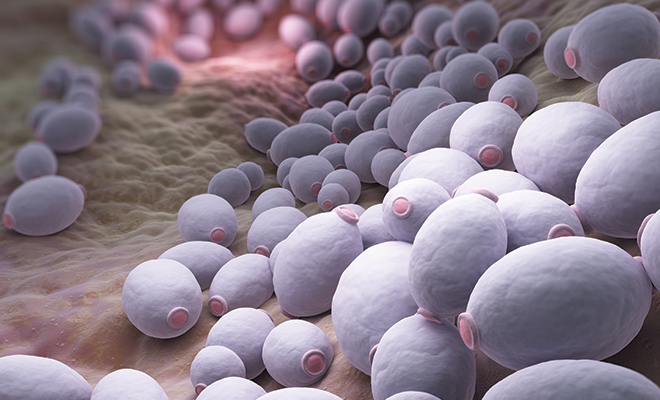
North, south, yeast and west
Yeast overgrowth. Those two words just sound unpleasant, and for the 70 percent of people who have had excess yeast in their body at some point in their lives, it can be a sticky subject in many ways. Fatigue, frequent mood swings and insomnia are just some of the symptoms of this prevalent medical issue.
Having too much yeast in the body isn’t just a vaginal problem, and adult women aren’t the only ones susceptible to the condition. Understanding what yeast is and how it affects your body is a good start to fighting this fungus and getting back on the path to optimal health.
What is yeast overgrowth?
Candida albicans is a fungusthat grows as a yeast, and a very small amount of it lives in your body. While candida aids in digestion and nutrient absorption, an overabundance of it can break down the walls of the intestines, enter the blood stream and cause frustrating health issues. The good news is that once you understand the early symptoms of candida overgrowth, you can take the correct steps to treat it.
Test yourself
Are you suffering from yeast overload? Try a couple of simple tests to detect if your body has too much. Simply look in the mirror and stick out your tongue. If you can see white plaque formed on your tongue, you may have yeast overgrowth.
Or try a spit test. As soon as you wake up in the morning, fill a clear glass with a cup of water. Spit in the water and then peek inside. Healthy spit floats, but if you notice strings, cloudy specks or smelly saliva, you may have issues with yeast.
Make an appointment with your doctor if you speculate you have an overgrowth of yeast. Your doctor can order blood tests for Candida antibodies called IgG, IgA and IgM. A comprehensive stool test can identify the species of yeast as well as what treatment will be the most effective.
Candida causes
Candida overgrowth gets a bit confusing since many of the symptoms can point to other health conditions. However, some of the most common causes raise red flags for potential overgrowth.
People who have been on antibiotics for long periods of time are at particularly high risk for developing yeast overgrowth. Since antibiotics are prescribed to wipe out bacteria, the drugs often kill the good flora as well as the harmful flora; they can disrupt the body’s balance of microorganisms and yeast colonies can grow in the large and small intestines. A dangerous condition called “leaky gut” can develop, in which the yeast cells create tiny holes in the small intestine, compromising the gut lining and allowing bacterial toxins, undigested food particles and other chemicals to invade the bloodstream.
Other medications such as birth control pills and oral corticosteroids (including prednisone), which are commonly prescribed to control inflammatory and autoimmune conditions, can cause overgrowth. Excessive alcohol consumption is another major culprit, since alcohol contains sugars that nurture Candida growth, as does a diet that is high in sugar and refined carbohydrates. Other factors that can increase a person’s susceptibility to Candida are stress, a weakened immune system, hormonal changes from pregnancy and diabetes.
Combating the Candida culprit
Sugar feeds yeast, so cutting the sugar and carbohydrates you consume will help tremendously. Nix candy, desserts, alcohol and flour. Cut back consumption of complex carbs to just one cup a day of foods such as grains, beans, bread, pasta and potatoes. Eliminate fermented foods; while these help to feed the good bacteria, they feed bad bacteria as well. Your doctor may prescribe an antifungal medication such as Diflucan or Nystatin for a short time.
Probiotic supplements such as acidophilus and bifidus can help rebuild the good gut flora. It could take a few months before you notice a difference in how you feel. Many factors determine how long it takes to get candida under control: the strength of the immune system, the level of emotional and environmental stress, and the health of the individual organs being treated. With a good attitude and the right defenses, yeast overgrowth can be treated successfully and life can get back to normal. HLM
Sources: mindbodygreen.com, needs.com, shape.com and draxe.com.
Symptoms of yeast overgrowth
Your body is probably telling you if you have Candida overgrowth. Here are symptoms to look for.
– Chronic fatigue lasting six months accompanied by joint pain and headaches
– Fibromyalgia
– Digestive issues, bloating, cramps, constipation and diarrhea
– Sinus infections, sore throats and allergies
– Autoimmune diseases such as Hashimoto’s thyroiditis, rheumatoid arthritis,
ulcerative colitis, lupus, psoriasis, scleroderma or multiple sclerosis
– Difficulty concentrating, poor memory, lack of focus, ADD, ADHD and brain fog
– Skin and nail fungal infections, such as athlete’s foot or toenail fungus
– Skin issues such as eczema, psoriasis and rashes
– Mood swings, irritability, depression or anxiety
– Vaginal infections, urinary tract infections, rectal and/or vaginal itching







